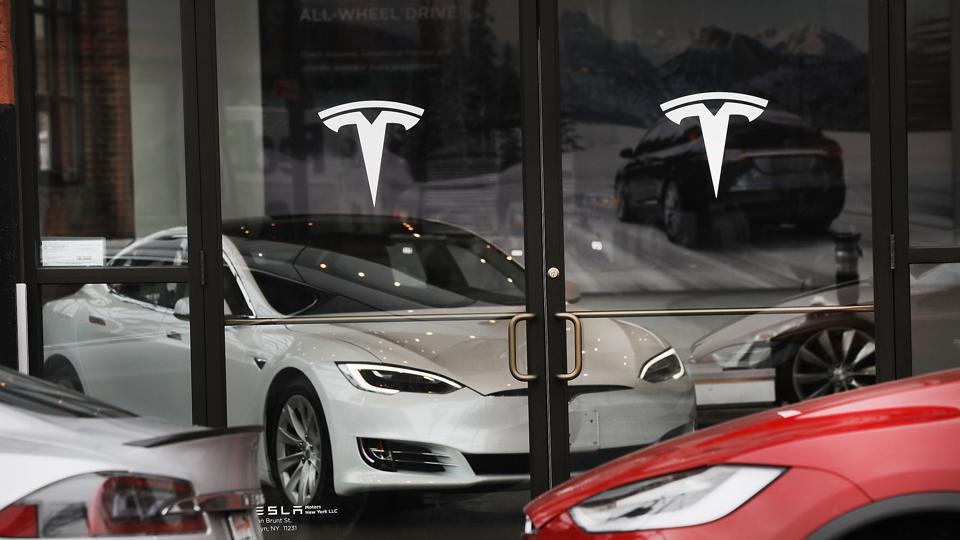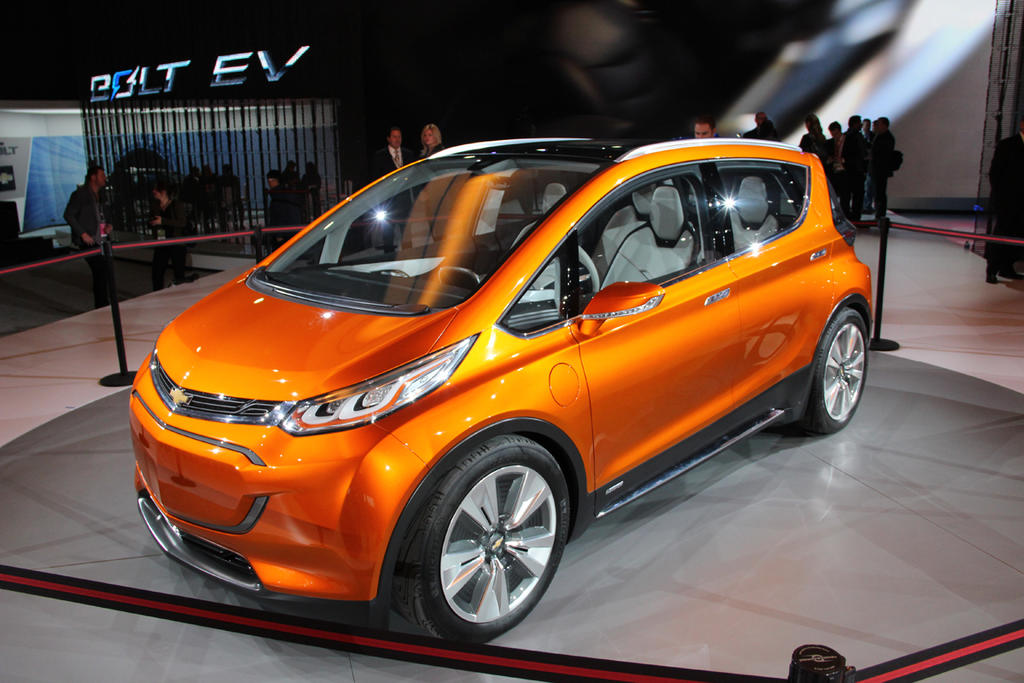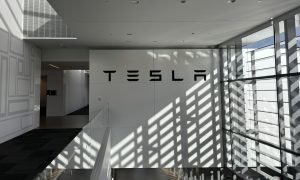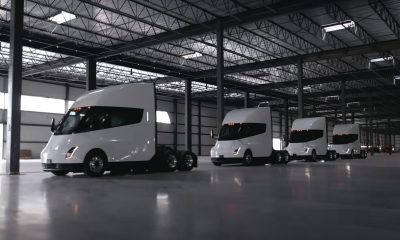

News
Tesla vs The Big Three – An uneven contest
Elon Musk has said many times that his ultimate goal is to increase the adoption of electric vehicles, a goal that’s advanced with every EV that rolls off a dealer’s lot, even if it’s not a Tesla. “The biggest impact that Tesla will have is not the cars that we make ourselves, but the fact that we show that you can make compelling electric cars that people want to buy,” he said in Revenge of the Electric Car.
When it comes to making compelling electric cars, the company has succeeded spectacularly. But when it comes to inspiring the industry leaders to sell their own EVs in substantial numbers, that isn’t happening. Spokesmen for the major automakers (especially when speaking to the EV media) say things like, “the future is electric,” and “we intend to stay at the forefront of technology,” but when it comes to action, the playbook is: sell just enough EVs to satisfy government regulators, while keeping the focus on profitable trucks and SUVs.
A recent article in CleanTechnica takes a look at the lineup of plug-in models offered by the Big Three (Ford, GM, and Fiat Chrysler). The current roster consists of 3 pure electric vehicles (EVs) and 5 plug-in hybrids (PHEVs). Of the 3 EVs, only one, the Chevy Bolt, is truly an attractive option. The Fiat 500e is a compliance car that’s only available in two states, and Fiat Chrysler CEO Sergio Marchionne has asked the public not to buy it. The Ford Focus EV was introduced in 2011, and not updated until 2015 – it sold a grand total of 901 units in 2016.
However, the handwriting is on the garage wall. Plug-in vehicle sales have increased every month for the last 20 months, Tesla’s Model 3 has accumulated somewhere around 400,000 advance orders sight unseen, and battery prices are falling rapidly – several industry observers have predicted that EVs will reach cost parity with legacy vehicles in about 5 years. So, is Detroit raising its game, and preparing to expand its portfolio of electric models?

Fiat 500e [Credit: Car and Driver]
Well, sort of. In January, Ford announced that it plans to introduce 13 new electrified vehicles over the next five years. However, it offered specifics for only 7, and only one of these is an electric vehicle for the US market: “an all-new fully electric small SUV, coming by 2020, engineered to deliver an estimated range of at least 300 miles.” The other 6 include hybrids and an electric commercial van to be sold in Europe.
Ford representatives have made it clear that the company will be taking a gradual, go-slow approach to electrification. CleanTechnica’s Loren McDonald spoke with Brett Hinds, Ford’s Chief Engineer of Electrified Powertrain Systems, in early January, and was left with the impression that the automaker feels little urgency about upgrading its electric vehicles. When McDonald mentioned that industry experts expect EV ranges to increase to 300 miles in 5-7 years, and that battery charging rates are also expected to improve, he was told that “Ford just doesn’t see it that way.” (Yes, this directly contradicts Ford’s official announcement quoted above – the major automakers often make contradictory statements about their electrification plans.)
More recently, Ford replaced CEO Mark Fields with Jim Hackett, the head of its Smart Mobility division, a move that is believed to signal more emphasis on electric and autonomous vehicles. Ford Executive Chairman Bill Ford confirmed this, telling Bloomberg in an interview that the CEO switch “is about EVs, and it’s about AVs [autonomous vehicles].” However, he seemed to acknowledge that the focus would remain on short-term profits (read: trucks). “Wherever we go, we have to make sure that the returns are great for our shareholders,” said Ford. When asked if he could foresee a future in which EVs would generate the kind of margins the company makes on the F-150 pickup, he thought silently for a moment, then changed the subject.
The voltage level is much higher over at GM, where the new Chevy Bolt has been earning rave reviews, and making respectable sales – it moved 1,566 units in May, #5 in the US plug-in ranking. However, the rollout has been slow – the Bolt went on sale in December 2016, but it still isn’t available in all 50 states.
“I wouldn’t necessarily call it a slow rollout; it was a phased rollout,” Chevrolet spokesman Jim Cain told Bloomberg. “In terms of sales, I think we’re right on plan.” And that’s kind of the point. As Elon Musk and others have pointed out, GM doesn’t seem to have any desire to sell the Bolt in mass-market quantities – it’s likely to limit production to 25,000 or so per year.
Ironically, the considerable media buzz around the Bolt seemed to disappear as soon as it actually went on the market. “The little car hasn’t captured any of Tesla’s Silicon Valley street cred, and it hasn’t whipped up any of the cultish following that still benefits the Toyota Prius,” writes Bloomberg’s Kyle Stock.
GM’s future electrification plans are vague. In February, GM CEO Mary Barra told CNET’s RoadShow that the Bolt platform will be the basis for a range of future EVs, but no details have been forthcoming.
And then there is Fiat Chrysler, the only automaker that has always been honest about its lack of interest in EVs. CEO Sergio Marchionne has said that the company loses about $14,000 on each unit of its Fiat 500e, and famously asked consumers not to buy it. The little electric runabout has garnered excellent reviews, can be leased for as little as $100 a month, and has been selling a surprising 600 or 700 per month, despite being available only in California and Oregon. Chrysler recently launched a plug-in hybrid version of its extremely popular Pacifica minivan, but it’s too early to tell how it will do.
One glaring problem is that the Big Three continue to put out lackluster designs for their electric cars. Diarmuid O’Connell, Tesla’s vice president of business development had said, “In essence, they’ve delivered little more than appliances. Now, appliances are useful. But… they tend to be unemotional.” Tesla’s CEO, Elon Musk, goes one step further, pointing out that an electric car shouldn’t “feel like a weird-mobile.”
On the other hand, the issue with the majors’ plug-in models has never been quality – almost all who’ve driven them, including this writer, agree that they are excellent automobiles. What remains puzzling is the companies’ willingness to market them. The automakers do almost no advertising for them, and most (not all) of their dealers do their utmost to steer customers away from them. Meanwhile, the companies continue to lobby to have fuel economy and emissions standards watered down.
A recent article in Plug-in Future, “How the Major Global Automobile Manufacturers Fell Asleep at the Wheel” notes a cling-to-the-past cultural dynamic. “Part of it comes down to mentality and culture. Senior executives in automobile companies tend to be [oftentimes] male mechanical engineers who… [enjoy] tinkering around with old cars and tractors. It’s what they do; it’s what they love and their careers have been about perfecting the highly complex internal combustion engine. And now you are telling them to get rid of that engine and replace it with a simple electric drive and a battery to power it. No wonder they are resistant… Changing such a culture is very difficult.”
So what gives? Is it short-sightedness? Fear of the future? Plain old stupidity? Not likely. Sure, they might be stuck in their ways but we’re talking about highly informed veterans of the auto business, who have access to all the same articles, statistics and reports that you and I do (much more, actually).
What’s really happening here is a phenomenon called The Innovator’s Dilemma (the title of a 1997 book by Clayton Christensen, and yes, I believe most auto industry execs have read it). Incumbent corporations can’t keep up with disruptive technological changes, because their shareholders demand quarterly profits. They can experiment with new technologies, but they can’t pursue them whole-heartedly, because that would mean cannibalizing their proven profit centers (to sell an electric car, you have to explain why it’s better than a gas car). Once a new technology improves to the point that it can offer similar capabilities (range, charging time) to the old at a similar price, the incumbents’ market can disappear surprisingly quickly – remember Kodak, Blockbuster, and Blackberry.
by Charles Morris
This story was originally published on EVANNEX
News
Tesla begins Robotaxi certification push in Arizona: report
Tesla seems serious about expanding its Robotaxi service to several states in the coming months.

Tesla has initiated discussions with Arizona transportation regulators to certify its driverless Robotaxi service in the state, as per a recent report from Bloomberg News. The move follows Tesla’s launch of its Robotaxi pilot program in Austin, Texas, as well as CEO Elon Musk’s recent comments about the service’s expansion in the Bay Area.
The Arizona Department of Transportation confirmed to Bloomberg that Tesla has reached out to begin the certification process for autonomous ride-sharing operations in the state. While details remain limited, the outreach suggests that Tesla is serious about expanding its driverless Robotaxi service to several territories in the coming months.
The Arizona development comes as Tesla prepares to expand its service area in Austin this weekend, as per CEO Elon Musk in a post on X. Musk also stated that Tesla is targeting the San Francisco Bay Area as its next major market, with a potential launch “in a month or two,” pending regulatory approvals.
Tesla first launched its autonomous ride-hailing program on June 22 in Austin with a small fleet of Model Y vehicles, accompanied by a Tesla employee in the passenger seat to monitor safety. While still classified as a test, Musk has said the program will expand to about 1,000 vehicles in the coming months. Tesla will later upgrade its Robotaxi fleet with the Cyercab, a two-seater that is designed without a steering wheel.
Sightings of Cybercab castings around the Giga Texas complex suggests that Tesla may be ramping the initial trial production of the self-driving two-seater. Tesla, for its part, has noted in the past that volume production of the Cybercab is expected to start sometime next year.
In California, Tesla has already applied for a transportation charter-party carrier permit from the state’s Public Utilities Commission. The company is reportedly taking a phased approach to operating in California, with the Robotaxi service starting with pre-arranged rides for employees in vehicles with safety drivers.
News
Tesla sets November 6 date for 2025 Annual Shareholder Meeting
The automaker announced the date on Thursday in a Form 8-K.

Tesla has scheduled its 2025 annual shareholder meeting for November 6, addressing investor concerns that the company was nearing a legal deadline to hold the event.
The automaker announced the date on Thursday in a Form 8-K submitted to the United States Securities and Exchange Commission (SEC). The company also listed a new proposal submission deadline of July 31 for items to be included in the proxy statement.
Tesla’s announcement followed calls from a group of 27 shareholders, including the leaders of large public pension funds, which urged Tesla’s board to formally set the meeting date, as noted in a report from The Wall Street Journal.
The group noted that under Texas law, where Tesla is now incorporated, companies must hold annual meetings within 13 months of the last one if requested by shareholders. Tesla’s previous annual shareholder meeting was held on June 13, 2024, which placed the July 13 deadline in focus.
Tesla originally stated in its 2024 annual report that it would file its proxy statement by the end of April. However, an amended filing on April 30 indicated that the Board of Directors had not yet finalized a meeting date, at least at the time.
The April filing also confirmed that Tesla’s board had formed a special committee to evaluate certain matters related to CEO Elon Musk’s compensation plan. Musk’s CEO performance award remains at the center of a lengthy legal dispute in Delaware, Tesla’s former state of incorporation.
Due to the aftermath of Musk’s legal dispute about his compensation plan in Delaware, he has not been paid for his work at Tesla for several years. Musk, for his part, has noted that he is more concerned about his voting stake in Tesla than his actual salary.
At last year’s annual meeting, TSLA shareholders voted to reapprove Elon Musk’s compensation plan and ratified Tesla’s decision to relocate its legal domicile from Delaware to Texas.
Elon Musk
Grok coming to Tesla vehicles next week “at the latest:” Elon Musk
Grok’s rollout to Tesla vehicles is expected to begin next week at the latest.

Elon Musk announced on Thursday that Grok, the large language model developed by his startup xAI, will soon be available in Tesla vehicles. Grok’s rollout to Tesla vehicles is expected to begin next week at the latest, further deepening the ties between the two Elon Musk-led companies.
Tesla–xAI synergy
Musk confirmed the news on X shortly after livestreaming the release of Grok 4, xAI’s latest large language model. “Grok is coming to Tesla vehicles very soon. Next week at the latest,” Musk wrote in a post on social media platform X.
During the livestream, Musk and several members of the xAI team highlighted several upgrades to Grok 4’s voice capabilities and performance metrics, positioning the LLM as competitive with top-tier models from OpenAI and Google.
The in-vehicle integration of Grok marks a new chapter in Tesla’s AI development. While Tesla has long relied on in-house systems for autonomous driving and energy optimization, Grok’s integration would introduce conversational AI directly into its vehicles’ user experience. This integration could potentially improve customer interaction inside Tesla vehicles.
xAI and Tesla’s collaborative footprint
Grok’s upcoming rollout to Tesla vehicles adds to a growing business relationship between Tesla and xAI. Earlier this year, Tesla disclosed that it generated $198.3 million in revenue from commercial, consulting, and support agreements with xAI, as noted in a report from Bloomberg News. A large portion of that amount, however, came from the sale of Megapack energy storage systems to the artificial intelligence startup.
In July 2023, Musk polled X users about whether Tesla should invest $5 billion in xAI. While no formal investment has been made so far, 68% of poll participants voted yes, and Musk has since stated that the idea would be discussed with Tesla’s board.
-

 Elon Musk1 week ago
Elon Musk1 week agoTesla investors will be shocked by Jim Cramer’s latest assessment
-

 Elon Musk3 days ago
Elon Musk3 days agoElon Musk confirms Grok 4 launch on July 9 with livestream event
-

 Elon Musk15 hours ago
Elon Musk15 hours agoxAI launches Grok 4 with new $300/month SuperGrok Heavy subscription
-

 News7 days ago
News7 days agoTesla Model 3 ranks as the safest new car in Europe for 2025, per Euro NCAP tests
-

 Elon Musk2 weeks ago
Elon Musk2 weeks agoA Tesla just delivered itself to a customer autonomously, Elon Musk confirms
-

 Elon Musk1 week ago
Elon Musk1 week agoxAI’s Memphis data center receives air permit despite community criticism
-

 Elon Musk2 weeks ago
Elon Musk2 weeks agoTesla’s Omead Afshar, known as Elon Musk’s right-hand man, leaves company: reports
-

 News2 weeks ago
News2 weeks agoXiaomi CEO congratulates Tesla on first FSD delivery: “We have to continue learning!”

















